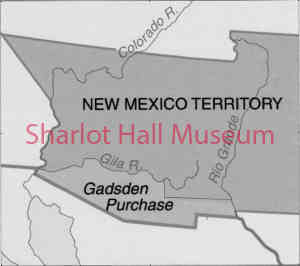By Al Bates
Originally published Feb. 23, 2013
Edited March 29, 2019
Arizona’s path to statehood began 156 years ago when President Abraham Lincoln signed the Organic Act separating it from New Mexico Territory and establishing it as a U.S. territory in its own right. However, this was not the first recognized Arizona Territory, for a previous version existed briefly as part of the Confederate States of America. And before that, early residents attempted to establish a “provisional” Arizona Territory.
Most of what we now know as Arizona became part of the federal union in 1850 when New Mexico Territory formally became part of the United States. The area was attached to the United States in 1848 as part of the Treaty of Guadalupe Hidalgo that ended the Mexican-American War. However, formal creation of New Mexico Territory was delayed for two years until the “Great Compromise” of 1850 established controls on the extension of slavery into newly acquired territories.
 It was not until after the Gadsden Purchase added land below the Gila River that the concept of a separate political entity called “Arizona” emerged. The first document to use that name came in an 1856 petition that called for separation of the Gadsden Purchase area from New Mexico Territory.
It was not until after the Gadsden Purchase added land below the Gila River that the concept of a separate political entity called “Arizona” emerged. The first document to use that name came in an 1856 petition that called for separation of the Gadsden Purchase area from New Mexico Territory.
It had been ratified in 1854, but formal takeover was delayed until the new dividing line between the two nations was surveyed and marked. February 20, 1856, marked the date that the last Mexican troops withdrew from Tucson, and tradition has it that a tiny group of pioneers (including William Kirkland) then raised the American flag over the “Old Pueblo” for the first time.
The opening years in the Gadsden Purchase were marked by the lack of law and order, caused in part by the distance from government in far off Santa Fe. It was not long before the residents began to petition Congress to enact separation from New Mexico Territory, only to be almost completely ignored. In desperation, they took the extreme step of forming a provisional government for an early definition of the new territory including selection of a full slate of territorial officers, including Dr. Lewis Owings as governor. All to no avail.
Their next move came with the creation of the Confederate States of America and the opening stages of the Civil War. In meetings at Mesilla and Tucson, those gathered voted to withdraw from the United States and petitioned to become a part of the Confederacy. Dr. Owings was retained as the provisional governor, and Granville Ory was assigned as territorial delegate to the Confederate Congress.
Later that year their efforts became pointless when an army of Texans invaded southeastern New Mexico Territory, and their leader, Col. John R. Baylor defined the Confederate Territory of Arizona, splitting it from New Mexico Territory along a horizontal line at the 34th parallel, a move that the Confederate government soon approved. He also declared himself the military governor of that Arizona and Dr. Owings was out of a job.
The Confederate Territory of Arizona was short-lived, ending when volunteer Union Army forces from California and Colorado drove the rebels back to Texas. At that point, General James H. Carleton, commander of the California volunteers, declared himself military governor of Arizona using the shape recently approved by the United States House of Representatives (but not yet approved by the Senate), thus becoming the third individual to hold the title of Governor of the Arizona Territory in one form or another.
Meanwhile, back in Washington D. C., Congress had continued the long debate over whether an Arizona Territory should be carved out of New Mexico Territory, and if so, what shape it should take. The House and Senate finally came to the agreement that President Abraham Lincoln would sign on February 24, 1863.
Up next: How Arizona’s Organic Act came to pass and the role of lame ducks and oysters.
“Days Past” is a collaborative project of the Sharlot Hall Museum and the Prescott Corral of Westerners International (www.prescottcorral.org). This and other Days Past articles are also available at https://sharlothallmuseum.org/articles/days-past-articles.l. The public is encouraged to submit proposed articles and inquiries to dayspast@sharlothallmuseum.org. Please contact SHM Library & Archives reference desk at 928-445-3122 Ext. 2, or via email at archivesrequest@sharlothallmuseum.org for information or assistance with photo requests.


